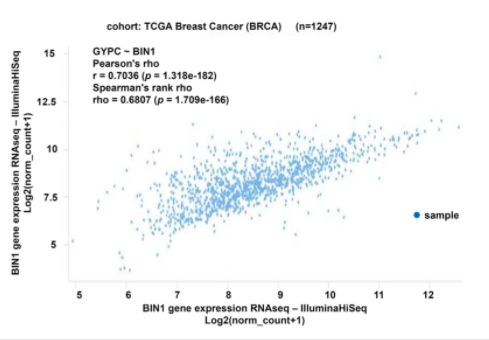Significance of BIN1 in breast cancer
Saha SK, Kader A, Samad KA, Biswas KC, Rahman A, Md. Parvez AK, & Rahman S. Prognostic and clinico-pathological significance of BIN1 in breast cancer. Informatics in Medicine Unlocked (2020)
How they used Xena
They used Xena’s Visual Spreadsheet and Chart View to construct part of Figure 6, where they examined the correlation between BIN1 and GYPC expression.

Figure 6D. Examining differences the correlation between BIN1 and GYPC expression in breast cancer.
Paper
Prognostic and clinico-pathological significance of BIN1 in breast cancer
Highlights
- BIN1 was found to be down expressed in various breast cancer subtypes.
- Low expression of BIN1 in breast cancer predicted a poor prognosis.
- BIN1 is predicted to correlate with the GYPC gene, and might inhibit breast cancer progression and prognosis.
Abstract
Bridging integrator 1 (BIN1) is a potential tumor suppressor that behaves as silent or misplaced in breast, prostate, skin, lung, and colon cancers. Previous studies noted decreased BIN1 expression in breast cancer (BC). Despite this, BIN1’s role in breast cancer is not well understood and remains to be elucidated. Here, we computationally analyzed BIN1 expression and its prognostic role in BC using various databases. Specifically, we found a down-regulated expression profile for the BIN1 gene in different BC subtypes using Oncomine, TCGA, and bcGenExMiner v4.2 web. The expression of BIN1 was found to be associated with various clinico-pathological conditions including estrogen receptor (ER), progesterone receptor (PR) basal-like subtype, and triple-negative breast cancer (TNBC) based on analysis of the bcGenExMiner v4.2 and TCGA databases. In addition to mRNA expression, the correlation between mRNA expression and BIN1 promoter methylation was established using TCGA datasets from UCSC Xena and ULCAN web, and we subsequently examined the relationship of BIN1 promoter methylation with different clinico-pathological conditions in BC patients. Data mining via Kaplan-Meier plotter indicated a positive association between lower BIN1 expression and low BC patient survival and various clinico-pathological conditions in BC patients. Furthermore, we identified a list of genes co-expressed with BIN1 in BC using TCGA data from the ULCAN web. Among the co-expressed genes, glycophorin C (GYPC) had the most predominant positive correlation. This correlation was further confirmed in BC using UCSC Xena and bcGenExMiner v4.2 webs. Overall, this study establishes that attenuated BIN1 expression might induce progression and poor prognosis in BC patients with GYPC association. This could be useful for clinical BC therapy.